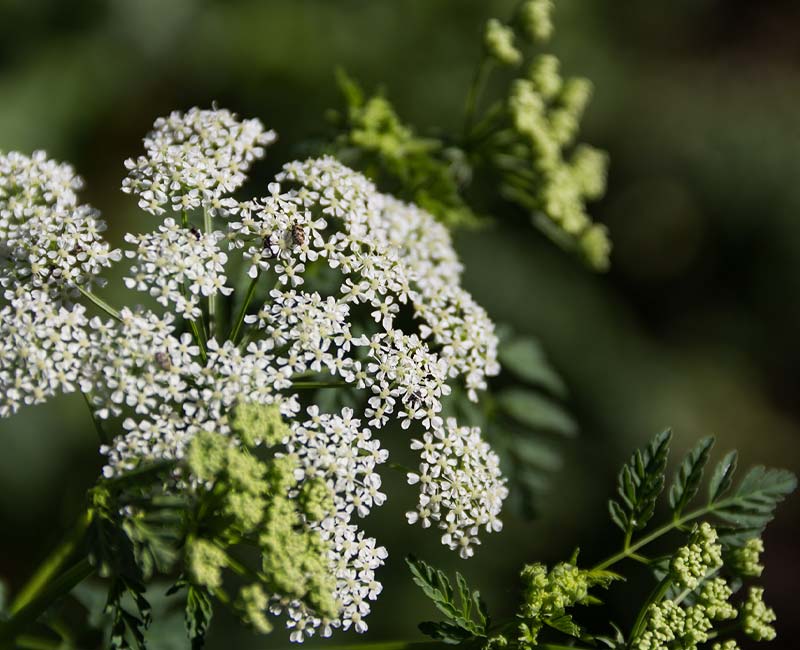Hemlock poisoning can occur if you accidentally ingest poison hemlock. Symptoms can range from vomiting to seizures to respiratory failure. There’s no antidote for hemlock poisoning. Your healthcare provider will treat your symptoms, but the condition can be fatal. You can prevent hemlock poisoning by getting rid of any hemlock plants in your yard.
Advertisement
Cleveland Clinic is a non-profit academic medical center. Advertising on our site helps support our mission. We do not endorse non-Cleveland Clinic products or services. Policy

Poison hemlock (Conium maculatum) is a highly toxic plant that’s a member of the carrot family. It’s commonly mistaken for wild carrot, wild parsnip or wild parsley. This can lead you to accidentally eat it (ingestion). Every part of the hemlock plant is poisonous, including the seeds, root, stem, leaves and fruit. It can be fatal if ingested. Ancient Greeks used poison hemlock to execute criminals or prisoners. The most famous example of this is the execution of Socrates.
Advertisement
Cleveland Clinic is a non-profit academic medical center. Advertising on our site helps support our mission. We do not endorse non-Cleveland Clinic products or services. Policy
Poison hemlock resembles Queen Anne’s lace. Settlers brought the pretty plant to the United States from Europe as a garden plant. Today, it grows throughout every region of the U.S. It grows along fences, roadsides and ditches, and in marshes, meadows and other low-lying areas. If you have eaten this poisonous plant, call 911 or go to your nearest emergency room. Hemlock poisoning can cause severe symptoms within 15 minutes of ingestion.
Poison hemlock identification can be difficult because it resembles other plants. The plant has a white root and a hollow stem with purple splotches. Hemlock can grow 2 to 10 feet tall. It has small, white flowers with petals that grow in an umbrella-shaped cluster. Each flower develops into a green, ribbed fruit that contains seeds. After it matures, the fruit turns grayish-brown. The delicate leaves of the plant look like parsley.
Poison hemlock isn’t like poison ivy, poison oak or poison sumac. You usually won’t get a rash from touching it. Most of the time, hemlock is only poisonous if ingested. However, you should still be careful when handling poison hemlock. In people with sensitive skin, dermatitis can develop. In very rare instances, hemlock poisoning can occur after the toxins enter your bloodstream. They can enter your bloodstream through a cut or through your eyes or nose (mucus membranes).
Advertisement
Hemlock poisoning symptoms can occur almost immediately after eating a poison hemlock plant. These symptoms may include:
In more severe cases, hemlock poisoning can cause delayed complications such as:
Hemlock poisoning can occur after ingesting even small amounts of poison hemlock. The plant contains several toxic compounds called alkaloids. These alkaloids slowly poison your neuromuscular junctions, which send messages from your nerves to your muscle fibers. This poisoning can cause your breathing muscles to fail. When your breathing muscles fail, you can go into respiratory failure and die. Hemlock poisoning can also affect your gastrointestinal tract, nervous system and cardiovascular system.
There isn’t a test to diagnose hemlock poisoning. Your healthcare provider will diagnose you based on your medical history and symptoms. If you have a sample of the plant, it can help confirm the diagnosis.
If you think you may have accidentally ingested poison hemlock, you should call your healthcare provider right away or go immediately to the nearest emergency room.
There isn’t an antidote for hemlock poisoning, so it can be difficult to treat. Your provider will treat you based on your symptoms and the severity of your condition. Treatment may include:
The outlook (prognosis) for hemlock poisoning depends on:
If you develop any symptoms of hemlock poisoning, get immediate medical attention. With prompt treatment, your chances of survival are better. After flushing the toxin out of your system, you may continue to have seizures and other symptoms for several days. Other symptoms such as muscle twitching and restlessness may persist for several months.
To prevent hemlock poisoning, the best thing you can do is eliminate the plant. To get rid of poison hemlock, dig it out in small patches. Make sure to remove the roots. You can use herbicide on the plants in late fall or early spring, but not after their flowers have bloomed.
Advertisement
Don’t cut, mow or burn poison hemlock — the seeds can re-sprout and the fumes can be toxic. Place the plants in plastic garbage bags and put them in the trash. Wear a face mask, long sleeves and gloves when handling poison hemlock.
If you work, camp or spend a lot of time outdoors, it’s important to become familiar with different types of poisonous plants. Don’t handle or eat any unfamiliar plants you find outside.
Poison hemlock looks a lot like other plants in the carrot family. It’s sometimes mistaken for wild parsnip, wild carrots or wild parsley. But if you accidentally ingest poison hemlock, it can be fatal. Severe symptoms can start within 15 minutes of ingestion. Unfortunately, there’s no antidote. Therefore, be careful when handling poison hemlock or any other plants you’re unfamiliar with. If you develop symptoms after handling or eating a plant, seek immediate medical attention. The sooner you get treatment, the better your chances for survival.
Advertisement
Whether you need stitches, a broken bone set or think your appendix might be causing your abdominal pain, Cleveland Clinic’s emergency medicine team is here to help.

Last reviewed on 09/08/2022.
Learn more about the Health Library and our editorial process.